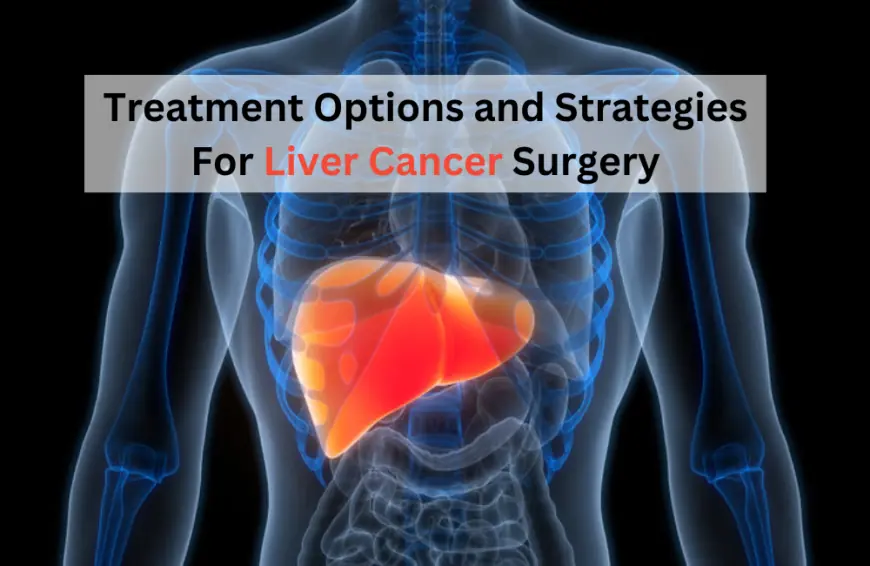Treatment Options and Strategies For Liver Cancer Surgery
Liver cancer surgery, as with every major procedure can have possible side consequences. These may vary based on the type of procedure done

Introduction
Cancer of the liver can be a very serious disease that usually requires surgery as part of the treatment. Surgery can be an effective method of battling liver cancer Patients and their families need to be aware of the possible side effects as well as the extensive treatment plans that are typically associated with the procedure. This article provides a thorough overview of what patients can anticipate when they undergo the procedure for cancer of the liver. The cancer physician from India plays a significant part in the treatment.
Explore effective treatment options and strategies for liver cancer surgery, including innovative approaches to treat cancer. Medications like Atraz and Docel enhance recovery and improve outcomes.
Different types of Liver Cancer Surgery
Before examining possible side effects and treatment options it's essential to be aware of the primary kinds of liver cancer treatment:
-
Partially Hepatectomy: Removing the portion of the liver that contains the tumor.
-
Liver Transplantation The procedure involves replacing the damaged liver with a healthy one from an organ donor.
-
Ablation The destruction of the tumor through cold, heat, or injecting alcohol.
-
Embolization blocks blood flow to the tumor to "starve" it.
The decision to undergo surgery is based on factors like its size, location, and extent of cancer as well as the general condition of the liver and the general health of the patient.
Affects associated with Liver Cancer Treatment
Liver cancer surgery, as with every major procedure can have possible side consequences. These may vary based on the type of procedure done and the individual patient's health condition.
Liver cancer treatment often involves side effects that impact daily life, but advanced therapies like Lenalidomide 25 offer hope in managing and treating cancer effectively.
Short-term Side Effects
-
Pain Post-surgical pain is normal and can be controlled with medications.
-
Infection The risk of infection either at the site of the incision or even inside.
-
Bleeding External or internal bleeding can occur, necessitating additional procedures.
-
Temporary liver failure is possible, particularly if a significant part that is seen in the liver has been removed.
-
Blood clots A higher chance of blood clots developing on the legs (deep vein thrombosis) or in the lungs (pulmonary embolism).
-
Bile Leakage In rare instances bile can leak out of the liver, which requires an additional procedure.
-
Pneumonia The prolonged time in bed may increase the chance of developing pneumonia.
Long-term effects of side effects
-
Liver Dysfunction: If a large portion of the liver has been removed, the rest of the liver could struggle to function properly.
-
Recurrence There is always a chance that cancer may occur again, which requires continuous surveillance.
-
Chronic Pain Certain patients might suffer from chronic pain or discomfort around the surgical site.
-
Nutritional issues The liver plays an essential role in metabolism and its diminished function can cause nutritional deficiency.
-
Psychological Impacts Cancer or major surgery may result in depression, anxiety, and other mental health issues.
-
Immunosuppression For patients with liver transplants, long-term immune suppressive drugs are required which increase the chance of getting sick as well as other health issues.
Treatment Strategies to Treat Liver Cancer
Liver cancer treatment often involves side effects that impact daily life, but advanced therapies like Anastrozole offer hope in managing and treating cancer effectively.
A complete treatment plan for cancer of the liver surgery usually involves several phases:
Pre-surgical Phase
-
Diagnostic tests Complete imaging (CT, MRI, PET scans) and tests of blood to determine the severity of cancer as well as general liver function.
-
Staging The determination of the stage of cancer to help inform the treatment decision.
-
The goal of pre-surgical optimization Improve the health of patients overall through exercise, nutrition,a nd managing other medical ailments.
-
Neoadjuvant Therapy In certain instances chemotherapy or radiation can be employed to shrink the tumor before surgery.
-
Patient education Informing patients about procedures, their potential dangers, and post-operative care.
The Surgical Phase
-
Anesthesia The administration of general anesthesia.
-
Surgery The procedure is the one that you choose to perform. Surgical procedure (partial liver transplantation, hepatectomy, etc. ).
-
Interoperative Monitoring Monitoring of continuous vital indicators and liver function during the procedure.
Post-surgical Phase
-
Insane Care immediate post-operative care at an intensive-care unit.
-
The concept of pain management Treatment of pain medication, and monitoring of levels of comfort.
-
Wound Treatment Regularly checking and cleansing the surgical site to reduce infections.
-
Monitor Liver Function Regular blood tests to check liver function.
-
Early mobilization Encouragement of patients to walk and move around as soon as safe to avoid complications such as blood clots, pneumonia, andothersr.
-
Food and Nutritional Assistance: ensuring the proper nutrition, which could include the feeding of a tube in case it is needed.
The Recovery Phase and the Follow-up phase
-
Slow Return To Activities A plan that is structured to assist the patient in a gradual get back to their normal routine.
-
Rehabilitation Therapy: Occupation therapy or physical therapy as required.
-
Regular check-ups Regular follow-up appointments to track recovery and look for indications of an occurrence.
-
Imaging Studies regular CT as well as MRI scans to determine cancer Recurrence.
-
Testing for Blooand d Liver function tests as well as tumor markers tests.
-
Additive Therapy Treatments like chemotherapy could be suggested to decrease the chance of repeat incidence.
-
Psychosocial support Counseling or support groups to assist with the emotional side of treatment for cancer.
-
Lifestyle modifications Guidelines for maintaining a healthy eating plan as well as a regular exercise routine, as well as aavoidingharmful substances such as alcohol.
How to manage side effects
A successful treatment of adverse effects is an essential element of the treatment plan.
-
Treatment for Pain A mixture of non-pharmacological and medical approaches (like methods of relaxation) can be used to manage the pain.
-
Prevention of Infections strict adherence to wound care guidelines and promptly reporting any indications of infection.
-
The Nutritional Help Work with a dietitian, you can make sure that you are getting the right nutrition, which is vital for proper liver function and recovery overall.
-
Exercise Introduction of gradual exercises,byh the approval of medical professionals, to enhance overall health and lower the chance of developing complications.
-
Psychological Assistance access to professionals in mental health who can deal with any psychological or emotional issues.
-
Medicine Management A careful monitoring and adjustments to medications especially for patients who have transplants using immunosuppressants.
Long-term Surveillance
After the initial period of recovery, the need for long-term monitoring becomes crucial:
-
Standard Imaging The typical procedure is to have CT or MRI scans performed every 3 to 6 months for the first 2 years, and then every year.
-
Testing for Blood Regular tests for liver function and examinations for tumor markers.
-
Lifestyle Management Support to maintain a healthy lifestyle that supports the liver's health and general well-being.
-
Secondary Prevention Monitoring for and managing the long-term consequences of treatments.
Conclusion
The treatment of liver cancer is a challenging process that needs a complete multidisciplinary approach to treatment. Although the adverse effects of this procedure can be serious, improvements in surgery techniques and post-operative treatment have dramatically improved the outcomes for numerous patients.
Understanding the possible adverse effects as well as the specifics that are included in the procedure could aid those who are undergoing treatment and families get ready for the challenges to come. Patients must remain in constant dialogue with their healthcare provider throughout the entire process starting with pre-surgical preparation and continuing through follow-up treatment.
If properly treated and managed Many patients recuperate well from a liver cancer operation and live happy lives. But the process does require perseverance, determination, and a robust support system. As medical technology is constantly evolving andimprovinge, we can expect improved treatment options and outcomes for patients suffering from liver cancer shortly.
What's Your Reaction?
 Like
0
Like
0
 Dislike
0
Dislike
0
 Love
0
Love
0
 Funny
0
Funny
0
 Angry
0
Angry
0
 Sad
0
Sad
0
 Wow
0
Wow
0























































